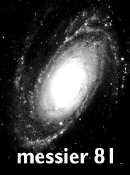 electronic music
electronic music 
Complete and available. Click here
for more info.
contents:
1. Premonitions (8:27)
2. Cirrus I (9:23)
3. Maximum Entropy (13:18)
4. Fragment Q306 (1:45)
5-8. Four Moons:
Phobos (1:21)
Deimos (2:37)
Pan (2:12)
Charon (4:34)
Notes:
The electronic music that most influenced me was
created in the electronic studios of Europe and the U.S. in the fifties
and sixties. I immersed myself in works such as those of Varèse,
Stockhausen, Berio, Arel, Davidovsky, Subotnick, Dockstader, and not
least
the electronic score by Louis and Bebe Barron for the 1956 film
Forbidden
Planet. These pieces and others inspired me to work with electronic
sounds
myself during my undergraduate years at Ventura College and the
University
of California, San Diego. After working several long summer months in
1972
on an electronic study using tape splicing techniques, however, I must
confess I began to look for more efficient ways to create electronic
music—and
found myself turning to improvisatory techniques. All the works on this
CD (and, in fact, all my electronic works to date) involve
improvisation
to varying degrees. With the exception of Maximum Entropy, the works
from
the period 1970–74 are also highly dependent on tape echo. I was
especially
encouraged in these pursuits by the excellent
I of IV (1966) by Pauline
Oliveros, which uses both improvisation and tape echo. I was fortunate
to have had several classes with her at UCSD; the second and third
pieces
on this CD were in fact composed during this time.
Premonitions
My most technically sophisticated work from this
period, Premonitions was created using a Moog IIIP synthesizer, a
sine-wave
oscillator (in one section), and three stereo tape machines. (It was my
first chance to record entirely on professional machines at
15 ips.) I
composed the overall outline of Premonitions first, then used layered
improvisations
to generate the details. It was designed from the outset to be mixed
down
from two stereo tapes running in sync. Most of the time the two tapes
had
contrasting material, and only two points required accurate
alignment—so
even though the tapes had to run for over eight minutes in this
fashion,
a good mix was accomplished in a few takes. The title refers not only
to
the work’s general atmosphere of foreboding, but to a compositional
technique
where certain prominent events occurring later in the piece are first
heard
in a subdued, disguised form in the opening minutes.
Cirrus I
This work is a live studio improvisation on a
Buchla
100-series synthesizer, recorded in real time with no overdubs or
editing.
The recorder, a Revox G36, had to be operated at 71/2 ips to obtain the
desired echo rate. The piece takes advantage of the Buchla’s unique
keyboard,
where the keys can be independently adjusted in any sequence; the
resulting
pitches tend to be microtonal. Cirrus I invokes the experience of
watching
slowly passing clouds—and, in its opening and closing minutes, the
sensation
of an intriguing unknown music heard at a great distance.
Maximum Entropy
Here is another live, unedited Buchla synthesizer
performance, this time without tape echo. Using almost every available
module, I organized the synthesizer into six distinct “instruments,”
each
of which was under keyboard control. Some I played directly, while
others
used random voltage generators or sequencers to create strings of
events
that I could start and stop as needed. The title is a term that
describes
a possible future state of the universe in which all energy potentials
are depleted; this work thus depicts the final moments of the universe
as it approaches complete stasis.
Fragment Q306
A tape on which I had recorded a long
multiple-feedback
experiment was eventually reused for other things, leaving only this
fragment
of retrograde Buchla synthesizer sounds. Its sense of urgency and
mystery
seems only intensified by its terseness.
Four Moons
Made with two monaural tape machines, a homemade
mixer, and a sine/square wave oscillator, these were among my first
electronic
explorations. Each piece has six layers of oscillator sounds, plus tape
echo added both normally and in reverse (a technique featured in
Forbidden
Planet). They convey a kind of lost, wandering quality, and, due to the
build-up of tape noise, distortion, and bias interference caused by the
semiprofessional equipment used, sound strangely old and remote.
top back